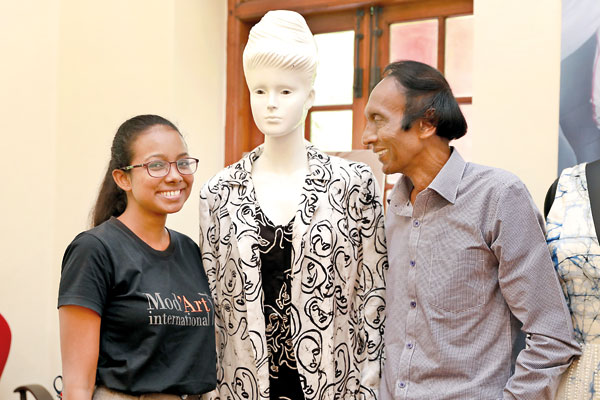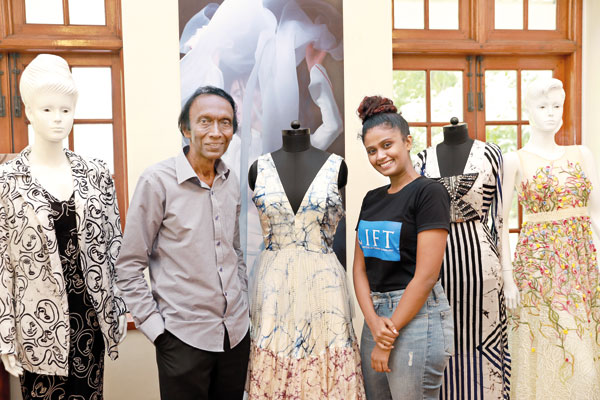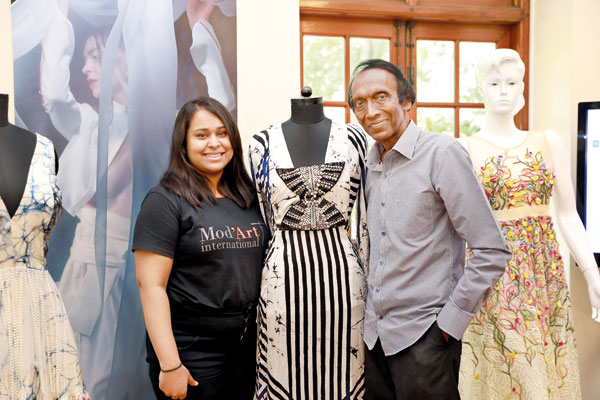Fashion Ignited By A Batik Infusion- Rekindling The Flames With Eric Suriyasena And Mod’Art International Sri Lanka
View(s):
Eric Suriyasena
Half a century was impotent to diminish the flame that burns within Eric Suriyasena. Even with 55 years of experience within the Batik Industry, the entrepreneur still attempts to deliver new elements to the society. Eric Suriyasena Batiks hosted an elegant and cultivated Batik Fashion show on the 26th July 2019 in Suriya Resort and Spa Marawila as an effort to ignite a passion for the industry within the next generation. 10 competitors representing Mod’Art International Sri Lanka and Lanka Institute of Fashion Technology dazzled the audience with individually inspired batik designs. The humble intellect behind the scenes Eric Suriyasena, and the 3 winners of the competition shared an elucidation regarding the importance of the craft while emphasising the value of fashion towards individual satisfaction as well as for economic growth.
What inspired you to get into the Batik Industry?
Art was a passion in my early childhood. That passion didn’t subside as I stepped into higher education. I had to experiment on subject matter until I decided to pursue my dream of fashion. It was never an intention to seek university education ( Geography,History) even if I was granted admission. Instead, Fine Arts was my source of inspiration. Upon my return from UK, the elegance of the Batik grasped my attention.
Where you certain that this new fashion trend would take-off within the Sri Lankan context?
At that time, Batik was merely a simple dress and was not of significant popularity. I sent a few collections of Batiks to my close associates throughout the globe for special occasions which derived enthusiastic feedback and gratitude. Consequentially, the desire to develop Batiks as a cottage industry took roots.
The concept bloomed once tourism gained prominence. Given the context, Batiks were relatively unheard of, and it was my duty to introduce the concept to the society, intending to take the Sri Lankan standards to the external world. This was done by hosting exhibitions in London and Paris to showcase the Sri Lankan Batik produce.

How has the industry evolved throughout the years?
Batiks gained a boost in popularity during the late 60s when tourists demanded the Sri Lankan versions to be taken as souvenirs. Traditional elements were incorporated within the Batik designs to fit themes like processions (peraharas) ,nature and religious events. The passion for the Batiks was still at its infancy, even though the tourists saw the craft in a more dignified light.

Give a snapshot on the competition which was hosted. Where you satisfied with the outcome?
The event was to commemorate 55 years within the Batik Industry as well as the Golden Jubilee for serving the tourism industry. The ideal manner for celebration is to hoard a compilation of talented young and budding designers along with their creations, and create a friendly competition.
The students of Mod’Art and Lanka Institute of Fashion Technology managed to ‘wow’ the audience with brimming potential. The usual trend of a fashion designer is to take the raw materials and create the final output; but it was evident that these students went a step further by designing their own entries from scratch. It is a source of pride to comprehend that the future is bright for these young individuals. The intention of these events is to showcase the diverse tactics of waxing and different techniques of dying that was never seen before.

How does the Batik Industry affect tourism?
It’s a highly sought after craft internationally. The Marawila factory was instituted with 500 workers and over 50 personally trained artists to facilitate the demand. The decisive fact is that foreigners coveted the products as a fashion sense as well as a souvenir. The design elements over-powered the routine shirts, sarees and sarongs that the Sri Lankans were generalized to wear. As a result, a considerable portion of foreign income flew into the domestic economy. The fact that Sri Lankan Batiks are completely hand-made acts as the selling point.
What do you think of your greatest achievement?
As a young enthusiast with Art on my conscience, I never imagined that the industry shall turnout as illustrious as it is now. Making a prosperous future for the young generation is my ultimate dream. I have achieved everything that was aspired. Each milestone I celebrated, regardless if it is the Silver, Ruby, Golden or Diamond jubilees are a dignified achievement. The journey was glorious, and I dont have any wishes to give up just yet, even if the external pressures start to mount. The fact that a platform is created for the younger generation gives great clarity and it is evident that the legacy shall continue throughout more generations to come.
What is your message to the society?
I have yet to feel the real Batik experience in a reputed fashion show. A fashion designer is an artist, and the designs are the art. Learning through experimenting is a must. This a multi-million dollar industry internationally. Everyone wishes to wear a Batik for work on certain days on different parts of the world; Malaysia( Thursday), Indonesia( Wednesday). Sri Lankans usually wear the formal attire for weddings while Indonesians prefer to wear Batik Shirts. Even international leaders of immense calibre wear Batiks for certain occasions thus the myth that the Batik Industry is ‘dying’ is non-factual.
The efforts of the young enthusiast who made the event a success is not to go unappreciated. The future minds of Mod’Arts gave insight on the experience that they received through the competition.
Malithi Shashi Prabha, who won 1st place claimed that her inspiration was derived through a more formal approach. The design that rose as the victor was a graceful 2 piece jump-suit and jacket. The logic behind the choice was the simplicity in which the design elements showcase 2 separate aspects of the art of Batiks. The runway show was an exciting challenge since the preparation was done while balancing college obligations. The stitching process was especially tedious since silk was used as the material. She expressed her gratitude towards Mod’Art International for acting as the source of inspiration and mentions that her future remains lit once her signature brand is established incorporating Sri Lankan craftsmanship.
Bithu Silva, a student of Lanka Institute of Fashion Technology, won 2nd place in the competition, and she voiced out the manner in which her inspiration was derived through the Bohemian style. The Bohemian style was recreated by merging typical Couture standards, which made her entry stand out from the rest. This was her choice of design since she wanted her entry to remain unique. It was exhilarating, as well as challenging, considering the time we had for preparations due to the hectic atmosphere. Handling silk is never an easy task. “It was an insightful experience that is to be cherished. My wish is to seek a career in fashion utilizing the experience and exposure given by the college. This was the boost that we needed, since it gave us an outlook on how the fashion industry operates.”
Piumi Senanayake was placed 3rd, but her entry was just as dashing. Her design had a natural artistic vibe since it was heavily inspired by the power suits/dresses which were a trend in the early 70s/80s. The entire concept was inspired by Vivienne Westwood who was more into punk. It was believed that punk and batiks are contrasting elements which do not complement one-another. Her entry proved otherwise since it attained the perfect balance of both elements which she boldly chose to represent. The middle piece embellishment manipulated can be used as shoulder-pads, which radiates a worthy ‘Power-Woman’ vibe. Similar to her colleagues her preparation was a hectic experience, and she proudly declared her gratitude and relief for her achievement, which she dedicates for Mod’Art International Fashion Institute. She plans to seek employment while incognito attempting to established a signature brand like her peers.
The entire effort was to remind the society about the Batik Industry, and all the promises were duly delivered. The legacy of Eric Suriyasena shall live on, through the flames that were ignited within these passionate young artists. The future for the Batik Industry remains scintillating, as long as the flame continues to linger.
- Randheer Mallawaarachchi


